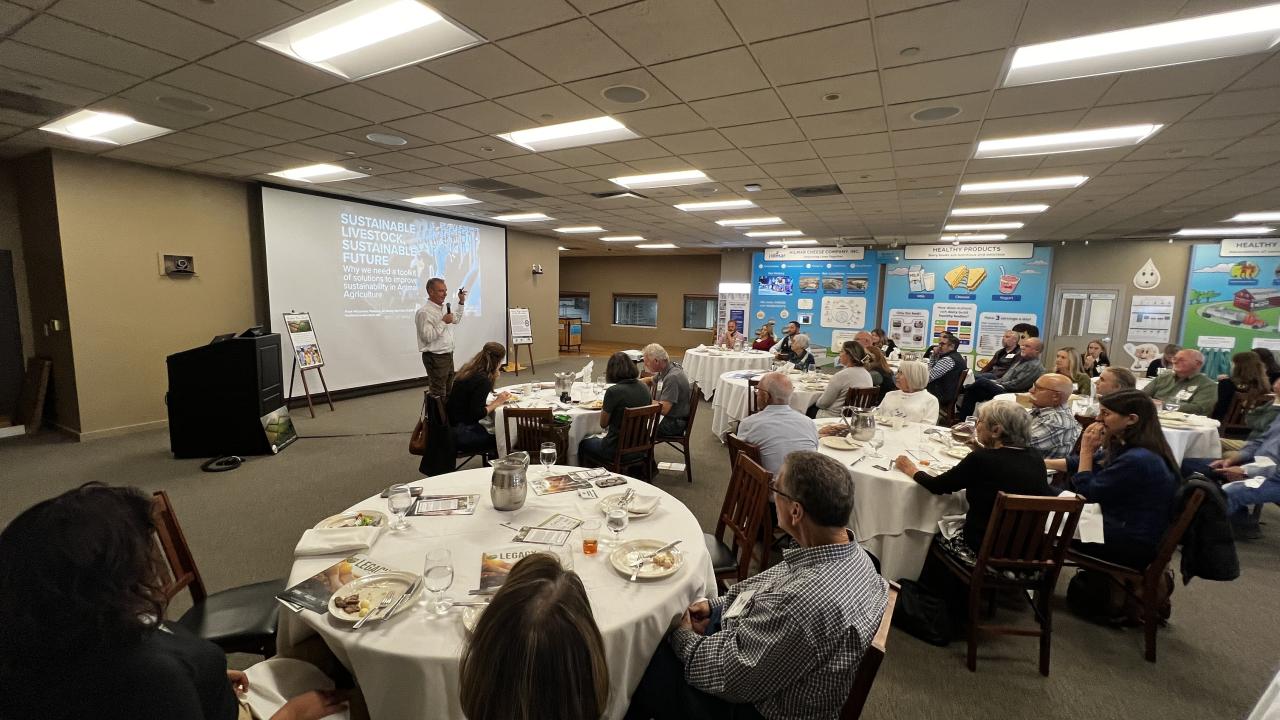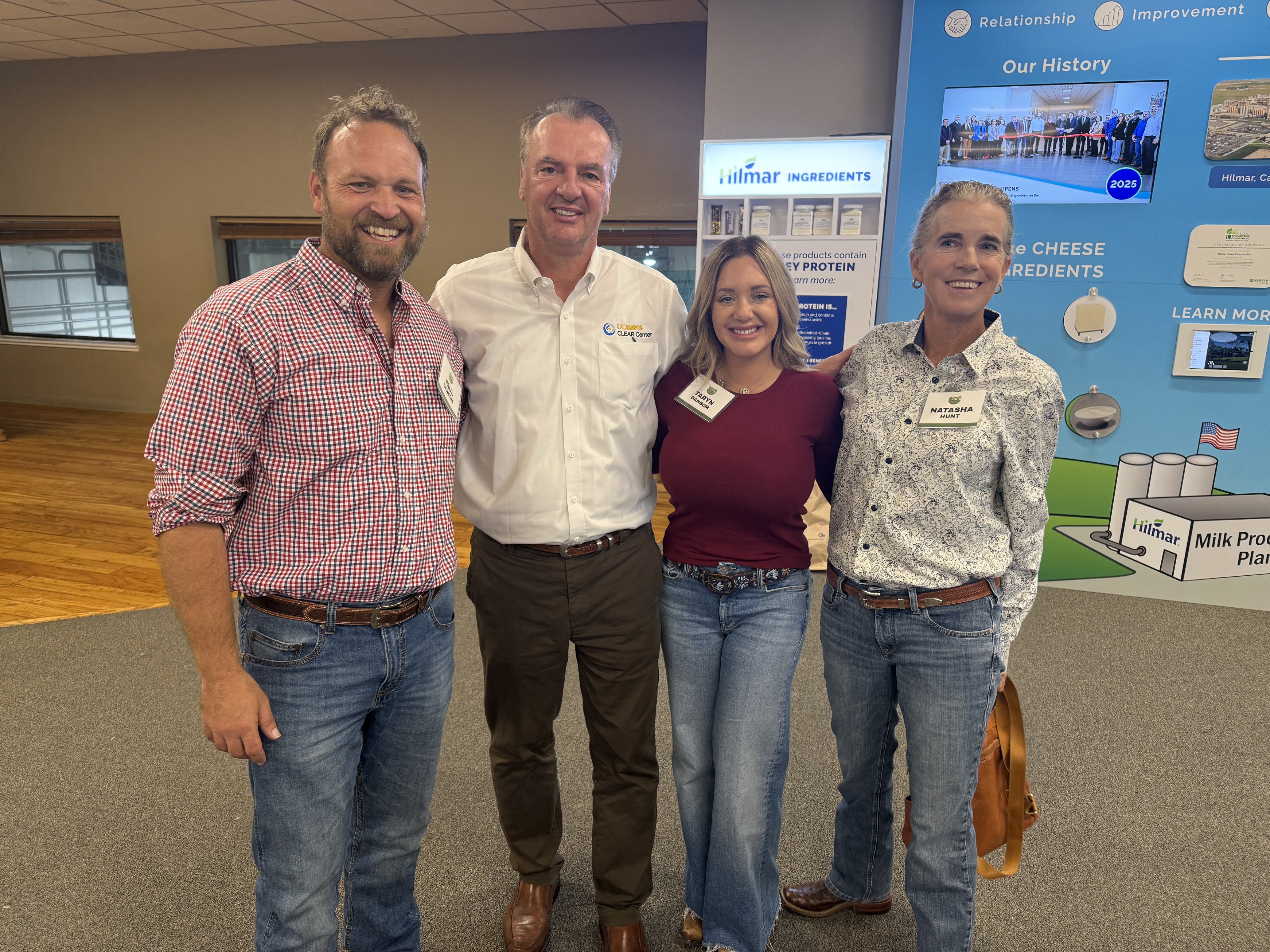
At the Table: Dr. Mitloehner Speaks at California Farmland Trust Event
At a time when farmland across California is giving way to housing developments, Dr. Frank Mitloehner had a clear message for those gathered a recent California Farmland Trust luncheon: protecting agricultural land isn’t just about preserving open space — it’s about securing the future of food production.
Speaking as the keynote speaker, Dr. Mitloehner, a UC Davis professor and air quality specialist, reminded the audience that California remains an “agricultural powerhouse,” producing half of the nation’s fruits and vegetables and the vast majority of its nuts.
For nearly 25 years, Dr. Mitloehner has called California home--but as housing developments expand across the Central Valley, he said, the need to protect farmland — and tell agriculture’s story — has never been more urgent. “These residential land uses are 70 times more environmentally harmful than agricultural land uses ever will be,” he said. “Yet people look out their windows, see a few cows, and say, ‘That’s where all the greenhouse gases come from.’ That’s the world we live in.”
With beef prices at historic highs and pressure mounting for climate-smart production, Dr. Mitloehner said the conversation around emissions has never been more relevant — or more misunderstood. “We can reduce emissions and improve efficiency — and that’s good for both the environment and the bottom line,” he said. “But people need to understand how and why.”
The California Farmland Trust works to protect the state’s agricultural lands from development, ensuring that farmland remains available for future generations. By conserving these working landscapes, the organization supports sustainable agriculture practices, helping farmers maintain productivity while protecting natural resources, preserving biodiversity, and reducing environmental impacts. Their efforts connect directly to sustainability by keeping farmland in production and promoting responsible land stewardship.
And as Dr. Mitloehner started his speech, he began by speaking about stewardship and sustainability.
“Oftentimes,” Dr. Mitloehner said, “I hear farmers express skepticism about sustainability.”
He smiled. “But if I asked you whether most farmers care deeply about their soil, their water, their air, their animals, their workers, and their products — would you say yes? Of course you would. Because that’s stewardship.”
He explained that sustainability rests on five pillars: environmental quality, animal welfare and health, workforce well-being, product quality and food safety, and financial viability.
“These are the five pillars of stewardship,” he said. “And they’re also the five pillars of sustainability. In the cities, they call it sustainability. In the countryside, they call it stewardship. I don’t care what you call it — it’s the same thing. It’s our legacy.”
But too often, he said, agriculture’s story isn’t told by those who live it. “When people ask questions about animal welfare or the environment, don’t look the other way,” he urged. “Be proud to explain what you do — because if you don’t, someone else will, and they might not get it right.”
Understanding Methane
“The word global warming has fallen out of fashion,” Dr. Mitloehner said. “It’s been replaced with climate change. But the general understanding is the same — the Earth is getting warmer.”
He explained that methane, produced by ruminant animals like cattle, is a potent greenhouse gas — but one that behaves very differently from carbon dioxide.
According to the U.S. Environmental Protection Agency, all of agriculture accounts for 10 percent of total greenhouse gases, with animal agriculture responsible for just 4 percent. “So the narrative that what we eat is the most contributing factor? That’s not true,” Dr. Mitloehner said. “That’s not what the EPA data say. But that doesn’t mean we’re off the hook. We are part of the problem — and we can be part of the solution.”
He compared greenhouse gases using the “global warming potential” scale: carbon dioxide as the baseline, methane as 28 times more potent, and nitrous oxide as 265 times stronger than CO2.”
Dr. Mitloehner illustrated his point with an analogy, comparing the different ways greenhouse gases warm the planet.
“The best analogy I can give is, let's say, you want to keep your coffee warm, put in a beverage container. It could be a Styrofoam cup, or it could be a China cup, or it could be a Starbucks $20 insulator cup,” he said. “You all know that these three beverage containers keep the coffee warm different length of time. The same is true for these greenhouse gases. Some are more powerful than others, entrapping heat from the sun.”
Dr. Mitloehner left the audience with a sense of both urgency and optimism. He reminded everyone just how far California’s livestock sector has come: already reducing methane emissions by about 5 million metric tons — an unprecedented achievement anywhere in the world. “We’ve already made tremendous progress toward our 7.2-million-ton goal,” he said. “And we’ve done it by working with farmers, not against them.”
That spirit of collaboration, he stressed, is what makes California unique. Technologies like dairy digesters and renewable fuels are transforming manure into clean energy, while new feed additives are on the horizon to drive emissions even lower. Together, these innovations are proof that progress doesn’t require choosing between environmental stewardship and agricultural productivity — it means pursuing both at once.
Reducing methane from livestock is no small task — especially as global demand for meat and dairy continues to rise, as Dr. Mitloehner explained as part of his discussion of the 2050 challenge.
“When I was a little boy, there were three billion people in the world,” he said. “Today, there are eight billion, and by the time I’m an old man, there will be 9.5 billion. Human population will have tripled during our lifetime — but the natural resources to feed those people will not have tripled. So the question is how do we feed the world’s population by the year 2050?”
He reminded the audience that the world will need roughly three times more food without three times more farmland, water, or fertilizer. “That means we have to be less wasteful, more efficient, and more productive,” he said. “And it means we need to stop converting farmland into something else. That, ladies and gentlemen, is why I’m here.”
Protecting Farms for the Future
Dr. Mitloehner emphasized the urgency of protecting agricultural land, noting that the conversion of farmland into other uses is one of the greatest threats to future food security. “We have to stop turning our most productive farmland into something else,” he said. “What’s happening up and down California — and across the world’s most fertile regions — is deeply concerning. That’s why what you’re doing here is so important. We need to tell that story.”
“What does it take for our sector to stand up and say, ‘We’re doing our job, and we’re doing it well?’” he asked. He urged the audience to keep sharing agriculture’s story — through blogs, videos, and social media — because, as he noted, “We don’t need the Wall Street Journal or The New York Times to tell our story. We can do that ourselves.”
His message resonated deeply with the room full of farmers, local leaders and students: agriculture is not the problem — it’s a central part of the solution. Around the world, Dr. Mitloehner explained, countries are still expanding their herds to meet nutritional needs, often without access to the tools and efficiencies available in the U.S. That’s why continued innovation — and sharing it widely — matters so much.
“I think the tide has turned,” he said, reflecting on how conversations about animal agriculture and sustainability have evolved. “I’m excited about the progress we’ve made, and we should all be proud of it. Because what you’re doing here — protecting land, producing food, and driving solutions — that’s what the world needs more of.”

He emphasized that California’s farmers and ranchers are already part of the climate solution — continually finding new ways to reduce emissions, improve efficiency, and protect natural resources.
That message came to life through the event’s highlight: the announcement of a new conservation easement for the 150-acre Danbom River Ranch Farm in Merced County, made possible through the California Farmland Trust. The River Ranch, established in 1962 by Paul Danbom’s grandfather and great-uncle, grows corn, oats, and alfalfa for its nearby dairy.
“I was raised that farming is an art,” Danbom said. With his land along the Merced River, he values the wildlife that visit his fields and strives to “leave as little a footprint” as he can.
The conservation easement ensures that this productive farmland will remain in agriculture for generations to come — aligning with the kind of regenerative, resource-conscious practices Dr. Mitloehner described in his talk. The project was supported by the California Strategic Growth Council’s Sustainable Agricultural Lands Conservation Program (SALC) in partnership with the California Department of Conservation, with additional funding from the Henry Mayo Newhall Foundation.
